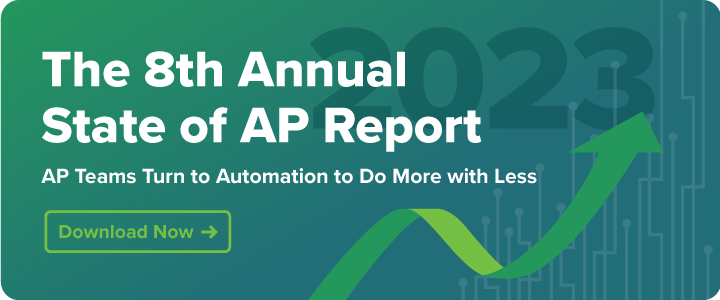As with many other business functions, finance departments stand to benefit from advanced technologies, including automation. But embracing automation and convincing executives of the benefits can be challenging. The first step of this process is determining which finance function to prioritize first.
Today’s blog is here to help with that. Keep reading to learn key finance automation challenges and trends; the importance of automation; high-priority automation functions within finance; and key components of a strong AP automation solution.
Key takeaways
- The industry is still facing many of the same COVID-challenges post-pandemic. Now, amid a recession, finance leaders are looking for ways to cut costs and do even more with less. The industry is still.
- Finance automation can help close the gap, enabling teams to increase efficiency, enhance viability and control, and reduce costs while creating a foundation for scalability.
- MineralTree’s AP automation solutions help support this industry shift by digitizing and automating the entire invoice-to-pay process.
What is finance automation?
Finance automation is the use of technology to carry out various financial processes automatically or without the need for human initiation. AP, AR, payroll and employee expenses are just a few examples of finance functions that can be automated.
What are the benefits of automation in finance?
Implementing automation in finance enables several benefits that help optimize efficiency and drive growth, including:
Increased efficiency
Automation in finance can help drive efficiency by minimizing human error, simplifying repetitive tasks like data entry, and cutting down on time spent on manual tasks. It allows teams to spend more time on strategic, analysis-driven work rather than time-consuming tasks that eat up increasingly valuable time.
In the 2023 State of AP Report, of the teams surveyed who are currently leveraging automation, 84% said they realized efficiency gains and 63% had faster, more timely payments. This boost in efficiency frees people up for more high-value work – after implementing automated processes roughly a quarter of finance leaders (24.4%) said they were able to reallocate freed-up staff time to other projects.
Enhanced visibility and control
Investing in automation tools can help finance leaders and vendors gain visibility and control over cash flow. This awareness enables teams to monitor transactions, ensure compliance, assess new and ongoing risks, accurately forecast budgeting, and more.
For example, 47% of survey respondents who say they have implemented automation in their AP teams say it helped them better manage cash flow. With enhanced visibility into things like invoice and digital payment data, they were able to make decisions with real-time data about where to prioritize efforts.
Cost savings
Many companies are looking to reduce costs, with 58% of finance leaders saying they are focused on boosting productivity. As companies look to reduce costs, the goal is to find ways to do more with less. Automation in finance supports this, with 17.1% of finance leaders whose teams are leveraging automation say they are now able to process the same volume they had previously with a reduced team size.
Scalable operations
With automation in place, teams can build a solid foundation for scalability and growth in the future. Processes can be more easily scaled up or down to accommodate for volume changes, and teams have greater capacity and flexibility to focus their efforts on more strategy-driven opportunities that drive growth.
What challenges face the financial industry?
Amid a recession, the mounting challenge in finance is finding ways to do more with less. In addition to lower budgets, CFOs are facing an accounting shortage. Lack of talent can lead to errors that can shake shareholder confidence and harm vendor relationships. In fact, Lyft, Planet Fitness, and Rivian Automotive have all reported mistakes on their earnings reports.
Despite progress being made, highlights from the 2023 State of AP Report also showed the industry is still facing many of the same difficulties brought on by the pandemic. Teams are still split across locations, with 68% of AP work environments now being hybrid or fully remote.
What are examples of financial functions that can be automated
Due to the challenges in the financial industry, 80% of CFOs are turning to digital transformation and automation to streamline their processes. This can come in many forms, making it difficult for firms to determine where to start their finance automation journey. Below are some common examples of financial functions that can be automated:
Accounts payable
Automating accounts payable includes invoice capture, approvals, payment authorization, and payment execution. Each process can be automated individually or as a whole. Companies with AP automation can reduce manual efforts associated with payments, while freeing up employee time to make more strategic business decisions.
Vendor management
Vendor management includes tasks such as enrollment, capture of payment preferences and associated information, account updates, and the ability to respond to inquiries. Software with an accounts payable vendor portal also makes it easy to manage and update vendor details, payment information, and account updates and gives both you and your vendors visibility into where an invoice is in processing and when to expect payment.
Accounts receivable
In accounts receivable (AR), tasks to automate include recurring invoices and payments, past due payment reminders, and more. Automation can create automatically generated invoices based on previous invoice data.
Payroll
Payroll can be a complicated process to manage manually, since finance teams may have to account for holidays, tax withholdings, benefits, overtime, and different salary levels.
Employee expenses
Employee expense management can be time-consuming for companies and employees. It involves approvals from management and employees to fill out expense reports, with receipts and proof of purchase.
Reporting & analytics
Reporting and analytics require collecting data about various accounts in one place, then arranging and analyzing it to gain insights into patterns and issues. With the right automation software, all of the data is automatically collected in one place, and reports can be generated instantly from it on demand.
The future of finance automation
In the Finance 2030 report, McKinsey found that finance leaders are spending more time on value-added activities than they did ten years ago (up 19%). Not only that, but over 50% of CFOs surveyed want to enhance the accuracy of cash flow forecasts with advanced analytics.
Forrester’s stats support this notion. They found that nearly 3 out of 4 financial leaders (74%) noted that the pandemic underscored the need for more accurate forecasting. But what does that mean for finance automation?
“The key to holistic cash forecasting is to capture data on outgoing cash payment obligations in approved AP invoices and on incoming cash receipts based on customer approval of submitted AR invoices,” Forrester said. “AP and AR invoice automation systems are the best sources of this advanced data.” Despite this, only 12% of companies have automated their AP and AR functions. It’s no surprise then that AP and AR are the top two focus areas for finance automation in 2022, according to our 2022 State of AP report. This automation enables teams to quickly obtain the data needed for accurate cash forecasting.
Why is AP automation important for finance?
By automating the entire end-to-end AP process, teams can reduce costs, ensure more accurate data, and achieve advanced analytics capabilities. Automating accounts payable can also improve:
Vendor management:
Vendor relationships have become more strategic over the past year due to supply chain issues. AP automation can help improve relationships with vendors by facilitating timely payments in each vendor’ preferred method. Automation also makes it much easier to manage and onboard vendors, pay them on time, and provide them with transparency into your processes.
Hybrid workforce:
Automation eliminates manual processes and paper handling by enabling a fully digital workforce. When employees are working in a remote or hybrid environment, being able to handle tasks digitally is vital. With AP automation, invoice approval is done via email, making it easy to facilitate approval from anywhere.
Scalability:
Sometimes invoice volume fluctuates or even increases dramatically in the event of rapid business growth. These changes are very difficult to meet with manual processes and would require increases in headcount. In contrast, automation makes scaling much easier because those processes are all handled by computer.
Human Error & Data Accuracy:
When tasks are preset and handled automatically, there is less room for errors to enter the system. This streamlines processes and improves data accuracy.
Analytics:
An AP automation system keeps all captured data in one place and makes it easy to generate reports and analytics at the touch of a button. These reports will always have the most up-to-date information and can provide timely and actionable insights. Additionally, you can use data as soon as the invoice is captured, making it easier to gain an accurate understanding of your company’s current financial standing.
How to implement automation in finance
Here’s an overview of the process for getting started with finance automation:
Audit existing processes and create a roadmap
The first step to automation is understanding existing processes and setup, so that informed decisions can be made about where and how to streamline. Not all work will be made more efficient if automated, so it’s important to priortize tasks that will benefit the team the most. Focus on simple or repetitive processes that don’t require human touch or nuanced problem-solving.
The entire financial process does not need to be automated all at once and an agile approach is a great way to ensure that the entire digital transformation journey goes smoothly. Since AP is very manual and is an important component of ensuring vendor relationships continue to run smoothly, most teams indicate that this is the highest priority to automate.
Assign a point person or team
While the goal of automation is to free up the team’s time for more strategy-driven tasks, it’s important to assign responsibility for automation processes or tools. This will help ensure everything continues to run as it should and troubleshoot issues as they arise.
Build workflows
The next step is to begin mapping out the workflows, including triggers and actions, rules and approval hierarchies, and document and data routing. Consider leveraging platforms that integrate with existing accounting systems that allow tailored workflows to be custom-built for your environment.
Test implementation and train employees
Once workflows are in place, the final step is to test implementation and ensure everything is working smoothly. This gives teams a chance to catch any mistakes or gaps before introducing customer data into the system, helping to minimize data security risks. Once it’s been confirmed everything is working as it should, employees should be trained on the new process so that teams feel comfortable transitioning to the new system.
What to look for in an automation solution for finance
If you’d like to start using automation in your AP department, it’s important to find a solution that meets your needs. Look for the following as you compare different software and platform offerings:
Analytics capabilities:
If your system is going to collect data, you might as well be able to use it. Look for a solution that can produce instant reports and analytics from the data it collects.
Accurate data/invoice capture:
Automation solutions are only good if they capture data accurately. Note that some systems that rely on OCR technology for invoice capture may face significant error rates (as much as 10%). Seek out a solution that comes with extra steps to verify captured data accuracy before processing. For example, by deploying additional checks through human review, MineralTree’s OCR invoice capture capabilities ensure 99.5% accuracy for each invoice.
Visibility into process:
It’s difficult to trust automated processes if you can’t see how they are working or where invoices are in process. A proper solution should allow you to instantly find the answer to any invoice query.
Integration with ERP system:
Data should flow two ways between your AP automation software and your ERP system. This ensures that the ERP system remains the system of record for all accounting debits and credits after invoices are posted.
Final thoughts
There are numerous areas within finance to automate. The right AP automation solution should streamline AP processes, capture accurate data, provide visibility, and integrate seamlessly with your ERP system. Thankfully, MineralTree’s AP automation solutions were designed to do exactly that. MineralTree’s TotalAP digitizes and automates the entire invoice-to-pay process, improving your efficiency by up to threefold and even reducing costs. You can even scale instantly from processing hundreds to tens of thousands of invoices every month, supporting business growth without adding headcount. Ready to automate your Financial AP process? Request a free demo to learn more.
Frequently asked questions about automation in finance
Will finance be automated?
Automation in finance is growing rapidly as companies turn to emerging solutions in hopes of freeing up valuable time and eliminating human-error. According to our State of AP Report 2023, more than half (51.6%) have automated at least some of their AP processes.
What are the risks of automating in finance?
Automation in finance can introduce a number of risks including regulatory non-compliance, data privacy and security concerns, disruptions to ongoing processes and workflows, and inaccurate reporting if tools have not been accurately set up. These concerns can be addressed with the help of automation software like MineralTree, an end-to-end AP automation solution designed to streamline finance operations and increase efficiency.





